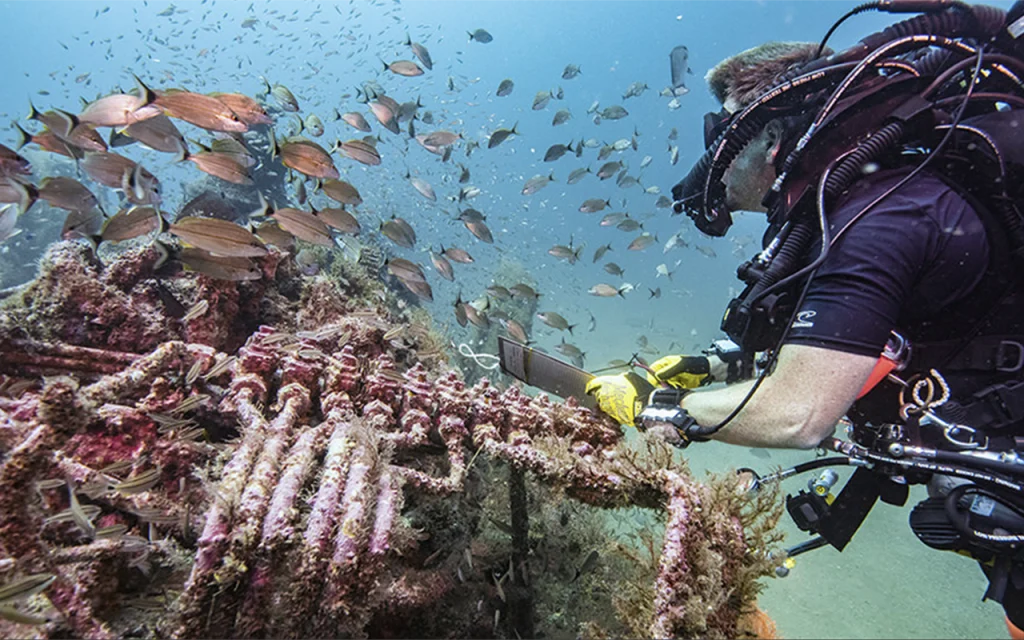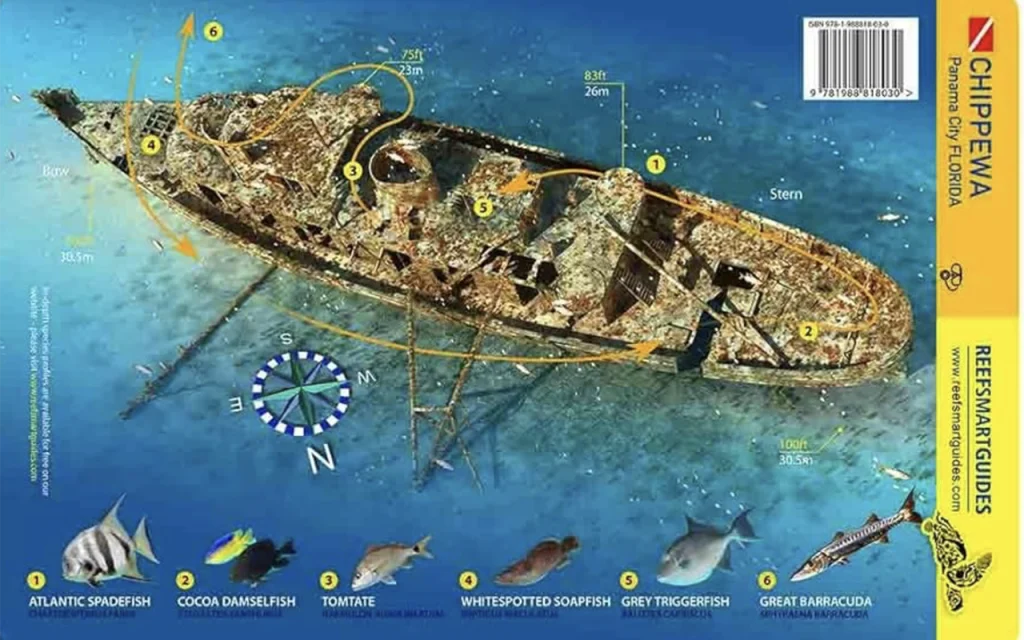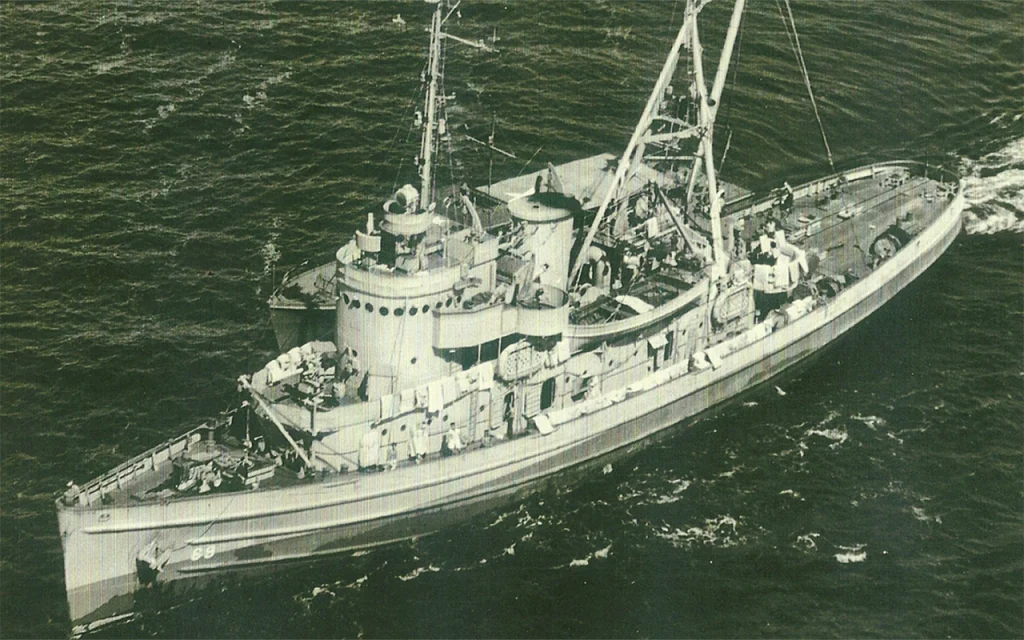Table of Contents

The USS Chippewa’s journey from a working naval tug to a cherished dive site illustrates its enduring legacy and the role it continues to play in marine ecology and recreational diving.
Article at a Glance
- Historical Background: The USS Chippewa, a Navajo-class fleet tug, was launched in 1942 and served the U.S. Navy during World War II, primarily in towing and salvage operations.
- Decommissioning and Sinking: After being decommissioned in 1947 and stricken from the Naval Vessel Register in 1961, the ship was sunk in 1990 to serve as an artificial reef and training platform.
- Location and Depth: The wreck is located off the coast of Panama City, Florida, at coordinates 29° 57.700′ N and 85° 48.220′ W, resting at a depth of approximately 100 feet (30 meters).
- Diving Experience: The USS Chippewa is a popular dive site known for its upright structure, good visibility, and accessibility for recreational and advanced divers.
- Marine Life: The wreck has become an artificial reef, attracting a diverse array of marine species, including snapper, grouper, sea urchins, starfish, and corals, making it a vibrant underwater ecosystem.
- Safety Measures: Dive charters provide pre-dive briefings, emergency equipment, and follow the buddy system to ensure diver safety. Environmental considerations are also emphasized to preserve the site.
- Visual Resources: While specific images of the wreck are not readily available, 3D-rendered dive cards can be purchased on Amazon, and the Florida Panhandle Shipwreck Trail website offers additional information and potentially visual content about the USS Chippewa.
USS Chippewa Wreck Location Coordinates and Depth
Depth
The wreck sits at a depth of approximately 90 feet (27 meters) and is a 205-foot long tugboat that was launched in 1942.
Location Coordinates
The wreck of the USS Chippewa is located at the following coordinates:
- Latitude: 29° 57.700′ N
- Longitude: 85° 48.220′ W

What to Scuba Divers Say About This Wreck
Dive Experience
- Training Platform: The USS Chippewa was sunk in 1990 to serve as a training platform for the Panama City Experimental Dive Unit. Divers appreciate the opportunity to practice their skills on a well-preserved wreck that is upright and accessible at a depth of about 100 feet. This has made it a popular site for both recreational and military divers.
- Marine Life: Divers frequently comment on the abundant marine life that inhabits the wreck. The structure provides an artificial reef, attracting various species, which enhances the diving experience. This aspect is particularly appealing to underwater photographers and marine enthusiasts.
- Historical Significance: Many divers express interest in the history of the USS Chippewa, which served in the U.S. Navy from 1943 until its decommissioning in 1946. The ship’s past, combined with its current role as a dive site, adds depth to the diving experience.
Community Impact
- Local Economy: The presence of the USS Chippewa as a dive site contributes to the local economy by attracting divers from various regions, which supports dive shops and related businesses in Panama City.
What Kind of Marine Life Can Be Found on The Wreck
- Fish Species: Divers have noted the presence of numerous fish species, including snapper, grouper, and other reef fish that thrive in the structure provided by the wreck.
- Invertebrates: The wreck is home to various invertebrates, such as sea urchins, starfish, and sponges, which contribute to the biodiversity around the site.
- Coral Growth: Over time, coral has begun to colonize the wreck, further enhancing its ecological value and providing habitat for marine organisms.
- Other Marine Creatures: Divers may also encounter larger marine animals, such as sea turtles and rays, which are often attracted to the rich environment surrounding the wreck.
Key Information
| Category | Details |
|---|---|
| Name | USS Chippewa |
| Type | Navajo-class fleet tug |
| Launched | July 25, 1942 |
| Commissioned | February 14, 1943 |
| Decommissioned | February 26, 1947 |
| Stricken | September 1, 1961 |
| Sunk | February 8, 1990 |
| Location | Off the coast of Panama City, Florida |
| Coordinates | 29° 57.700′ N, 85° 48.220′ W |
| Depth | Approximately 100 feet (30 meters) |
| Purpose | Artificial reef and training platform for the Panama City Experimental Dive Unit |
| Marine Life | Snapper, grouper, sea urchins, starfish, corals, and other reef fish |
| Diving Conditions | Good visibility, accessible for recreational and advanced divers |
| Safety Measures | Pre-dive briefings, emergency equipment, buddy system, environmental considerations |
What Makes USS Chippewa a Unique Diving Experience
Historical Significance
- Military Background: Launched in 1942, the USS Chippewa served the U.S. Navy in various capacities, including towing and salvage operations. Its history includes laying mooring buoys and breaking speed records, which adds a layer of intrigue for divers interested in maritime history.
- Training Platform: After its decommissioning, the Chippewa was sunk in 1990 to serve as a training platform for the Panama City Experimental Dive Unit. This unique purpose enhances its value as a dive site, as it has been used for training Navy divers for decades.
Dive Conditions
- Accessibility: The wreck is located at a depth of approximately 100 feet, making it accessible to a wide range of divers, from recreational to advanced levels. Its upright position on the ocean floor allows for easy exploration.
- Good Visibility: The waters around Panama City are known for relatively good visibility, which enhances the diving experience, allowing divers to appreciate the wreck’s structure and the marine life that inhabits it.
Marine Life
- Artificial Reef: The wreck has transformed into an artificial reef, attracting a diverse array of marine life. Divers can expect to see various fish species, invertebrates, and even larger marine animals like sea turtles and rays, enriching the underwater experience.
Ecological Impact
- Habitat Creation: The USS Chippewa contributes to marine biodiversity by providing a habitat for numerous species. This ecological role not only supports local marine life but also enhances the diving experience, as divers can observe these creatures in their natural habitat.
Community Engagement
- Local Economy: The presence of the USS Chippewa as a dive site supports the local economy by attracting divers from around the world, benefiting dive shops and tourism-related businesses in the area.
What is The Full History of This Wreck
Construction and Commissioning
- Laid Down: The USS Chippewa was laid down on June 26, 1942, at the Charleston Shipbuilding and Drydock Company in South Carolina.
- Launch and Commissioning: It was launched on July 25, 1942, and officially commissioned into the U.S. Navy on February 14, 1943.
World War II Service
- Operational Role: As a Navajo-class fleet tug, the Chippewa was primarily tasked with towing and salvage operations. It served in various capacities, including laying mooring buoys in Casablanca in 1944 and breaking tugboat speed records. The vessel was also notable for carrying a torpedo bomber on its fantail during its service.
- Theater of Operations: The Chippewa operated extensively in the Atlantic Ocean, including the Caribbean and Newfoundland. It was involved in several missions, including towing duties and salvage operations, until the end of World War II.
Decommissioning and Fate
- Post-War Decommissioning: After the war, the Chippewa was decommissioned on February 26, 1947, and placed in the Reserve Fleet in Orange, Texas. It remained inactive until it was transferred to the Maritime Administration in November 1960.
- Stricken from Naval Register: The ship was officially stricken from the Naval Vessel Register on September 1, 1961.
Transformation into an Artificial Reef
- Preparation for Sinking: In 1989, the USS Chippewa was selected to be sunk as an artificial reef and training platform for the Panama City Experimental Dive Unit.
- Sinking: On February 8, 1990, the ship was sunk using a network of explosive charges, allowing it to rest upright at a depth of approximately 100 feet (30 meters) off the coast of Panama City, Florida.
Current Status
- Diving Destination: Today, the USS Chippewa serves as a popular dive site, attracting recreational divers and military personnel for training. It has become an artificial reef, fostering marine life and contributing to the local economy through dive tourism.
- Ecological Impact: The wreck now supports a diverse array of marine species, making it a vibrant ecosystem and a significant site for underwater exploration.

What Historical Features Can Still Be Identified on Wreck
Identifiable Historical Features
- Upright Structure: The USS Chippewa sits upright on the ocean floor at a depth of approximately 100 feet, allowing divers to easily navigate and explore its structure.
- Tugboat Design: As a Navajo-class fleet tug, the ship’s design is characteristic of military tugboats, with features such as a robust hull and towing equipment that can still be recognized.
- Propeller and Rudder: The ship’s propeller and rudder are intact and visible, showcasing the engineering of its time. These components are significant for understanding the vessel’s operational capabilities.
- Mast and Superstructure: The remnants of the mast and superstructure can be seen, which were essential for navigation and communication during its service.
- Historical Artifacts: Various artifacts related to the ship’s operational history may be present, including remnants of equipment used for towing and salvage operations, as well as any gear that was aboard when it was sunk.
Ecological Features
- Artificial Reef: The wreck has become an artificial reef, with marine life thriving around it. Divers can observe how the ship has been colonized by corals, sponges, and various fish species, contributing to the ecological significance of the site.
Dive Experience
The combination of these historical and ecological features makes the USS Chippewa a unique dive site, offering both a glimpse into naval history and an opportunity to engage with marine biodiversity. Divers appreciate the well-preserved condition of the wreck and the chance to explore its historical significance while enjoying the vibrant underwater ecosystem surrounding it.
What Safety Measures Are in Place for Divers Visiting USS Chippewa
Safety Measures for Divers
- Dive Charters: Many divers access the USS Chippewa through organized dive charters, which provide experienced guides familiar with the wreck and its surroundings. These charters ensure that divers adhere to safety protocols and are aware of the dive conditions.
- Pre-Dive Briefings: Dive operators typically conduct pre-dive briefings that cover safety procedures, potential hazards, and the dive plan. This includes information about the wreck’s layout, depth, and the marine life divers may encounter.
- Depth Awareness: The USS Chippewa is located at a depth of approximately 100 feet (30 meters), which is within recreational diving limits. Divers are advised to monitor their depth and air supply closely to avoid decompression issues.
- Buddy System: Divers are encouraged to dive in pairs or groups, following the buddy system. This ensures that divers can assist each other in case of an emergency.
- Emergency Equipment: Dive charters are equipped with emergency oxygen supplies and first aid kits, providing immediate assistance if needed.
- Marine Life Awareness: Divers are educated about the local marine life, including potentially hazardous species like jellyfish, and are advised to maintain a safe distance from any marine creatures.
- Environmental Considerations: Divers are reminded to respect the wreck and its surroundings, following the principle of “take only pictures, leave only bubbles” to preserve the site for future divers.
Dive Shops That Prove Diving Trips to This Shipwreck
- Coral Reef Dive Shop: This shop organizes offshore dive trips that include dives to the USS Chippewa among other wrecks. They provide guided experiences for divers looking to explore this site.
- Scuba Panama City Beach: This dive shop specifically highlights the USS Chippewa as a popular dive destination. They cater to both recreational divers and those interested in training, making it a suitable choice for various skill levels.
North Florida Wrecks
- USS Oriskany
- USS Massachusetts
- SS Tarpon
- SS Gulf America
- Empire Mica
- USS Chippewa
- Avocet
- Black Bart
- The Vamar
- San Pablo
- USS Narcissus
- The Loftus Wreck
- The Dorothy Louise
- The Mizpah
- MV Janet
- The Eidsvag
- YDT-14 and YDT-15
- USS Strength
- Miss Louise
- The Lulu
- PC-1174
- Three Coal Barges
- USS Accokeek (ATA-181)
- El Dorado
- The Grey Ghost
- The Pete Tide II
- Red Sea Tug





